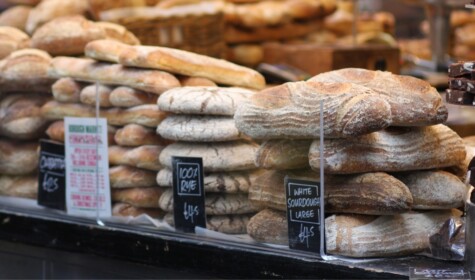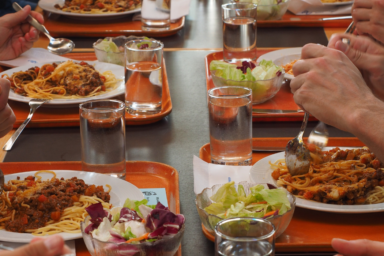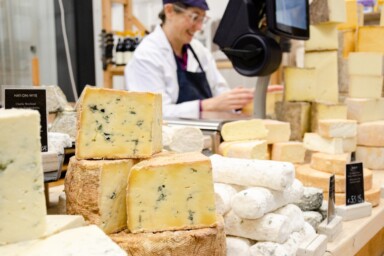What’s happened to bread over the last 60 years or so is something of a tragedy – an elemental food source was turned into a nutritional deficit. With the arrival of the industrialised bread-making processes of Chorleywood, almost everything about the making of bread has changed, including the introduction of enzymes, preservatives, texturisers and industrially produced yeasts. Bread, which is traditionally based on four ingredients – flour, salt, water and yeast – now contains a tongue-twisting array of additives, with the UK’s departure from the EU prompting concerns that the standard of our bread may soon deflate to new lows. In-house supermarket bread, the kind that looks freshly baked, that most of us think of as the healthy bread option in the store, is among the worst.
Despite a short-lived explosion in the popularity of home baking during the COVID-19 lockdown year, Britain is not a country of bakers. Statistics show that almost half of Brits have never baked and a further 19% bake less than once a month. So, within the broad category of home-baking, we can assume that baking bread is not high on the agenda for most people. Yet bread remains a staple in most kitchen cupboards with 99.8% of British households buying it, amounting to around 11 million loaves being sold every day.
Bread is one of the foods – perhaps the only food? – that is widespread across almost every culture in the world. And, surprisingly, there is evidence that it may pre-date agriculture, so it really does go deep into the core of our evolution as a species. Given this, you could argue that we are losing something of ourselves in our loss of what is now called ‘real’ bread. Is it a sense of longing that arises from this loss that prompts the periodic spikes in the popularity of home bread-making? Perhaps it offers a way of restoring us to a deeper, more connected state in our frantic and fragmented information age.
My relationship to bread is one of emotional familial ties. My mother baked bread when I was growing up in the 1970s. She baked deeply wholesome brown bread, which went into the lunches that I took to school. Her sandwiches were stodgy and often soggy, especially when they were made with tuna. I didn’t dislike them but negotiating them was sometimes tricky as they were often drippy. And when they weren’t drippy, they were sticky – made with peanut butter – and the bread stuck to the roof of my mouth when I bit into them, taking some time for me to chew them well enough to be able to swallow. Sometimes, I wished I could have the Wonder Bread my friends’ sandwiches were made from.
My mother also made a rustic ‘French’ bread for dinner parties, which could be lovely or deadly. If overcooked, it became crunchy enough to break a tooth on and I have memories of gnawing on it, trying to make my way through the crust to the bready bit. As an adult, I tried to make it, based on the recipe she scrawled on an index card that I have carried with me for decades – it was not a success and after several attempts, I gave up on recreating it and moved on to more palatable recipes.
Perhaps surprisingly, my mother left me with an enduring love of good bread. Living in San Francisco in the 1990s, good (real) bread abounded and while it cost more than the crappy, processed supermarket bread, it wasn’t that much more. That’s changed now – ‘artisan’ bread, while very much worth the money, is unquestionably expensive. Visiting a friend in San Francisco on a recent return to my home state, I was shocked to find that her sourdough bread was running at $8 (£6) a loaf. Artisan bread in the UK remains more tenably affordable (unless you are in Central London), thank god!
My husband and I both bake bread and have done for many years – he, much longer than me. He has become quite an impressive home-baker of good sourdough. Our bread baking is pretty much a daily thing. We’re farmers and we have a roster of volunteers who live with us throughout the year and come to learn about growing food and what it demands. Most are young and have ferocious appetites – if we didn’t bake the bread ourselves, we’d go bankrupt. On the whole, our volunteers are amazed that we bake so regularly; baking bread is still largely perceived as an onerous, complicated process by the uninitiated.
To be honest, I’ve never been a great bread maker. I do the easy breads and stay away from the sourdough (why compete!). I make tortillas when we’re eating Mexican, simple flat breads for wraps, a brown batter bread that is quick and easy, a yeasted white bread (great for sandwiches) and my most favourite, soda bread. Soda bread is so distinctive in its flavour – a deep salty deliciousness – and so easy to make. It’s great if you are in a hurry as you can make it from start to finish in around an hour. As a starter loaf for the beginner baker, it’s a very satisfying initiation.
Soda Bread Recipe
Although it can be argued that it’s not the ‘realest’ of breads due to the use of soda as a raising agent, I love making this loaf for its ease and deliciousness.
From Hugh Fearnley-Whittingstall’s ‘River Cottage Family Cookbook’
This is a double recipe, making an ample loaf:
- 18 oz (510 g) good quality flour – white, wholemeal or a mix
- 2 tsp baking soda
- 2 tsp salt (flaked sea salt is really nice in it)
- 4 tsp dark brown sugar
- 450 ml plain yoghurt or buttermilk
Mix ingredients in a large bowl with fork until they pretty much stick together, then bring together in a ball with your hands (the dough will be sticky – you can add a little flour if it’s super sticky).
Place your loaf on an oiled baking sheet and cut the top into a cross, creating space between the cuts.
Heat oven to 230 degrees Celsius and bake for 12 minutes; then reduce to 200 degrees Celsius for a further 15 – 20 minutes. Check the top isn’t soft at the end of baking and if so, give it a few more minutes.
Let sit for about 15 minutes on a baking rack before slicing. This bread is best eaten immediately, but will make nice toast on the following day.







